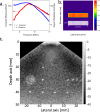Flexible large-area ultrasound arrays for medical applications made using embossed polymer structures
- PMID: 38555281
- PMCID: PMC10981753
- DOI: 10.1038/s41467-024-47074-1
Flexible large-area ultrasound arrays for medical applications made using embossed polymer structures
Abstract
With the huge progress in micro-electronics and artificial intelligence, the ultrasound probe has become the bottleneck in further adoption of ultrasound beyond the clinical setting (e.g. home and monitoring applications). Today, ultrasound transducers have a small aperture, are bulky, contain lead and are expensive to fabricate. Furthermore, they are rigid, which limits their integration into flexible skin patches. New ways to fabricate flexible ultrasound patches have therefore attracted much attention recently. First prototypes typically use the same lead-containing piezo-electric materials, and are made using micro-assembly of rigid active components on plastic or rubber-like substrates. We present an ultrasound transducer-on-foil technology based on thermal embossing of a piezoelectric polymer. High-quality two-dimensional ultrasound images of a tissue mimicking phantom are obtained. Mechanical flexibility and effective area scalability of the transducer are demonstrated by functional integration into an endoscope probe with a small radius of 3 mm and a large area (91.2×14 mm2) non-invasive blood pressure sensor.
© 2024. The Author(s).
Conflict of interest statement
A patent application has been filed by the authors (L.C.J.M.P., J.-L.P.J.v.d.S., R.G.F.V., P.L.M.J.v.N., and G.H.G.) under the number EP3869575A1. This patent describes the technology and device structure of the ultrasound transducers used in this work. PillarWave is a trademark of TNO. The remaining authors declare no competing interests.
Figures





References
-
- Cobbold, R. S. C. Foundations Of Biomedical Ultrasound (Oxford Univ. Press, 2007).
-
- Szabo, T. L. Diagnostic Ultrasound Imaging: Inside Out (Academic Press, 2014).
-
- Global Business Intelligence. Ultrasound systems market to 2019—Technological advancements, wide applications and device portability to drive future growth. https://www.gbiresearch.com/report-store/market-reports/medtech/ultrasou... growth (2013).
-
- Omidvar A, Cretu E, Rohling R, Cresswell M, Hodgson AJ. Flexible polyCMUTs: fabrication and characterization of a flexible polymer-based capacitive micromachined ultrasonic array for conformal ultrasonography. Adv. Mater. Technol. 2023;8:2201316. doi: 10.1002/admt.202201316. - DOI
MeSH terms
LinkOut - more resources
Full Text Sources

